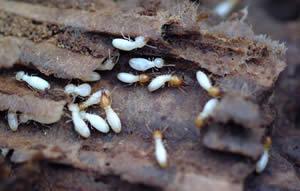Termites
Termites are also known as white ants, this is because of their colouring, being white or white like and they look similar to normal ants, but are actually related to the common cockroach.
There are literally hundreds of species of termites but only about 20 that attack your home.
While all termite species thrive in different climates and eats different types of food, all termites require four things to survive, these are Food, Moisture, Shelter and optimal temperatures. It is unfortunate that your home provide all of these conditions to allow white ants to explode into a termite infestation.
It is imperative to have regular inspections done by a licensed pest controler, Termite protection should not be taken lightly and is as important as having home insurance. If you have home insurance which covers termite damage but do not have a proper termite barrier in place, your insurer more than likely will not pay you out.
You can do your own inspections but this should not take place over a licensed pest inspection or controller.
What you can do;
Do & Do-nots
-
Do–not allow materials to build up around your home or adjoining structures,
-
Do–not allow soil or garden mulch to raise higher than the building foundations or weep holes,
-
Do–not block weep holes,
-
Do repair water leaks,
-
Do clean gutters,
-
Do remove any stored timber and junk under house.
Inspecting yourself;
When looking for signs of termites your looking for what looks like mud tunnels, these are made up of excrement, plant matter, saliva and soil. Termites do not like and try to avoid the light and exposure as they must stay moist and can easily be over powered by ants and other predators.
Outside the house in the garden;
-
Gardens and their edges,
-
Timber stakes and mulch,
-
Timber logs,
-
Fallen branches,
-
Wood piles,
-
Timber steps,
-
Retaining walls &
-
Damp areas
-
Decks and pergolas,
-
Pool pump housings and screens,
-
Timber kennels,
-
Cubby houses,
-
Fences,
-
Gate posts,
-
Fire wood &
-
Stored timber.
Around the house;
-
Weep holes,
-
Weather board edges,
-
Piers,
-
Air conditioner units/ condenser,
-
Ant capping,
-
Outside the Bathroom &
-
Laundry.
Under the house (if you have a raised floor)
-
External foundation walls,
-
Piers/Stumps,
-
Under wet areas, Bathroom Laundry & kitchen,
-
Chimney Bases,
-
Check and then remove timber and rubbish.
Inside your home;
This is a systematic procedure, you are looking for cracked or bubbling paint, going from room to room and everywhere between, tap along your skirting boards and windows using a screwdriver handle, even tap your plaster board listening for any sound differences. Move your furnishings where possible to do a proper job, the beds, lounges, cupboards & book shelves. Check in and around built in wardrobes.
If your able check inside your ceiling/roof space looking for signs of termites and tapping joists and rafters listening for sound differences

